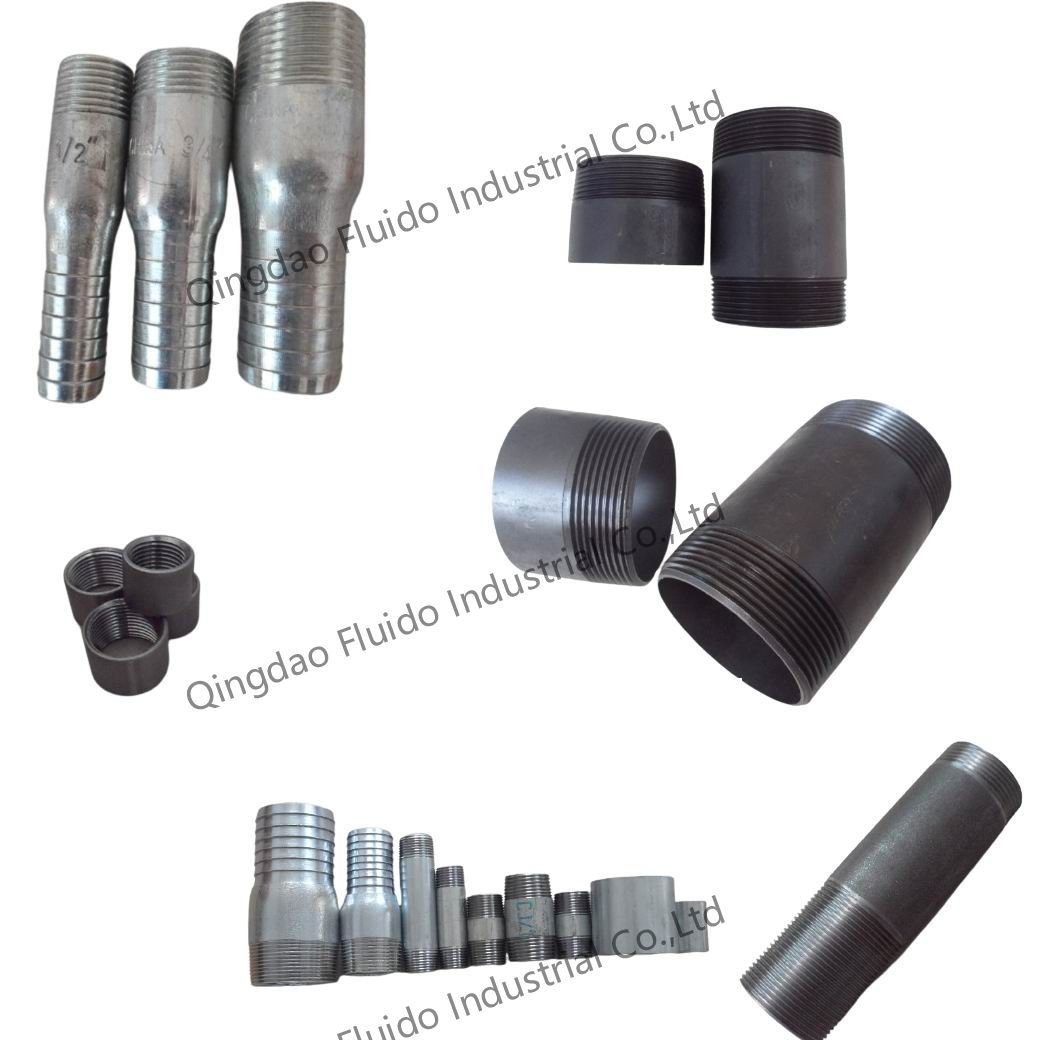Export Office: 21Floor, No.5 Nanhai Zhi Road,Qingdao, Shandong ,China
Work Shop: Beian Industrial zone, Qingdao,Shandong,China
+86 532 88550858
Martin
Inquiry now
Understanding Pipe Nipples
What is a Pipe Nipple?
A pipe nipple is a short segment of pipe, typically featuring male threads on both ends, used to join two other pipes or fittings. They are available in various sizes and materials, which makes them highly adaptable for numerous plumbing and industrial uses. Generally, the threading is NPT (National Pipe Thread), although other standards may be applied based on regional specifications. These threaded ends enable a secure and tight connection, which is essential in systems that manage pressurized fluids or gases.
For the sake of meeting strict quality requirements and industry standards, FLUIDO is certified to the international ISO9001 quality system standard and all products are carefully tested before shipment. Since “trust originates from quality”, we have passed not only the European CE certification for our valves and flanges products, but also the ISO9001 assessment and registration by SGS for quality management.

Common Applications of Pipe Nipples
Pipe nipples are integral components in domestic, commercial, and industrial plumbing projects. Within residential environments, they frequently facilitate connections in bathroom and kitchen plumbing applications, such as linking faucets to the primary water supply line. In commercial and industrial contexts, pipe nipples play a crucial role in intricate fluid transfer systems, including oil and gas pipelines, water treatment plants, and chemical processing facilities. Additionally, they are utilized in HVAC systems to connect various elements of heating and cooling infrastructure.
Materials Used in Pipe Nipples
Pipe nipples are manufactured from a variety of materials to suit different applications and requirements. Common materials include galvanized steel, stainless steel, brass, and PVC. Galvanized steel and stainless steel are typically used for their strength and resistance to corrosion, making them ideal for industrial and outdoor applications. Brass is often used in domestic plumbing due to its resistance to corrosion and its longevity. PVC and other plastic materials are lightweight and resistant to various chemicals, making them suitable for less demanding and non-pressurized systems.
Factors Affecting the Length of Pipe Nipples
Standard Lengths for Pipe Nipples
Pipe nipples usually come in standard lengths ranging from 1 inch to 12 inches, measured from end to end. Standard lengths are essential because they allow for predictability and uniformity in plumbing projects. These pre-determined lengths make it easier to plan and execute projects without the need for custom-fabricating pieces, which can save time and reduce costs.
Customizing Length Based on Application
When standard lengths are insufficient, a custom length may be necessary to fulfill the specific needs of a project. Custom pipe nipples can be ordered or cut precisely to the required length. This level of customization is especially crucial in complex systems where space limitations demand exact measurements. Additionally, tailoring the length contributes to optimal flow dynamics in fluid systems, enhancing efficiency and minimizing the risk of malfunctions.
Impact of Threading on Length
The threading of a pipe nipple can significantly affect its effective length. The threads on both ends typically reduce the overall useful length of the pipe nipple by about 1/4 inch to 1/2 inch, depending on the size and type of threading used. Thus, when measuring for a project, it's crucial to account for the threaded areas to avoid mistakes in assembly. Purchasing pre-threaded nipples minimizes this error, but for custom cuts, this aspect must be considered carefully.
Measuring and Sizing Pipe Nipples
How to Measure Pipe Nipple Length Accurately
To accurately measure the length of a pipe nipple, one should measure from end to end, including the threaded portions. However, consider that part of the threading will be engaged into the connecting fittings, effectively shortening the usable length. Using a caliper tool or a specially designed pipe nipple gauge can help ensure precise measurements, which are essential for seamless assembly and system integrity.
Important Considerations When Measuring
When measuring pipe nipples, it's vital to consider the type and depth of threading as these factors affect the overall usable length. Also, remember to measure the internal diameter if you're working on a project that requires a specific flow rate. Ambient temperature and material expansion characteristics should also be taken into account, especially in systems exposed to temperature fluctuations. Lastly, ensure that the material is compatible with the fluid or gas it will transfer to avoid corrosion and contamination issues.
Choosing the Right Pipe Nipple for Your Needs
Selecting the Appropriate Material
When selecting the appropriate pipe nipple for your needs, the choice of material is essential. The most frequently used materials include galvanized steel, stainless steel, brass, and PVC. Each material has its own benefits and is best suited for specific purposes. For example, galvanized steel is commonly used in outdoor applications because it resists rust and corrosion, making it ideal for water systems exposed to the elements. Stainless steel offers superior strength and excellent corrosion resistance, making it perfect for high-pressure systems and industrial environments. Brass is preferred in domestic plumbing systems due to its durability and ability to withstand wear and tear. PVC and other plastic materials are selected for their lightweight nature and chemical resistance, often used in systems that do not require high-pressure ratings.
Ensuring Compatibility with System Requirements
Ensuring compatibility with your system requirements is another essential consideration when selecting a pipe nipple. It's crucial to match the material to the type of fluid or gas that will be transported through the system. For example, choose a material that does not react with or degrade when exposed to specific chemicals or temperatures. Additionally, the size and threading type must be compatible with the existing piping and fittings in your system to achieve a leak-proof and secure connection. Compatibility also extends to temperature and pressure ratings, ensuring that the pipe nipple can withstand the operating conditions without failure. Always refer to manufacturer specifications and industry standards to ensure you are selecting components that meet the operational needs of your entire system.
Installation and Maintenance of Pipe Nipples
Proper Installation Techniques
Implementing proper installation techniques is critical to ensuring the longevity and efficiency of pipe nipples. First, ensure that all components, including pipes and fittings, are clean and free from debris. Properly preparing the threads by cleaning and potentially lubricating them with thread sealant or Teflon tape can help create a secure, leak-free connection. It's important to follow the recommended torque specifications to avoid over-tightening, which can damage the threads or lead to cracks in the material. Align the pipe nipple carefully with the fitting, and use the correct tools, such as pipe wrenches, to tighten the connections without distorting the threads. Correct alignment minimizes stress on the joints, ensuring that the connection remains intact under operational pressures.
Regular Maintenance Tips to Ensure Longevity
To ensure the longevity of pipe nipples, regular maintenance is essential. Periodically inspect the connections for signs of wear, corrosion, or leaks. Early detection of issues allows for timely repairs or replacements, preventing more extensive system failures. If the pipe nipple is part of a system that handles corrosive substances or operates under fluctuating temperatures, more frequent inspections may be necessary. Keep the area around the connections clean and dry to avoid introducing contaminants that could compromise the integrity of the seal. Additionally, when performing maintenance, use appropriate protective gear and follow safety protocols to avoid accidents. Lastly, maintain accurate records of inspections and any maintenance performed, which helps in tracking the lifespan of the components and planning for future replacements or upgrades.
Different Types of Pipe Nipples
Close Pipe Nipples
Close pipe nipples are a unique type of pipe nipple that have threading along their entire length. This feature of being fully threaded enables the shortest possible connection between two fittings or pipes, effectively removing any unthreaded pipe length. These are particularly advantageous in space-limited environments where a minimal gap between components is needed. Due to their compact design, they are often used in high-precision applications, such as instrumentation and control systems. Close pipe nipples can be manufactured from various materials based on specific requirements, including stainless steel, brass, and PVC.
Hexagon and Reducing Nipples
Hexagon and reducing nipples serve different but equally important functions in plumbing and piping systems. Hexagon nipples feature a hexagonal middle section that allows for easy turning with a wrench, facilitating installation and removal. These nipples usually have male threading on both ends and can vary in length, making them suitable for a wide range of applications. Reducing nipples, on the other hand, have different diameters on each end, enabling the connection of pipes with unequal sizes. This feature is vital for adapting piping systems to accommodate various flow rates and pressures. Made from durable materials like stainless steel and brass, hexagon and reducing pipe nipples are commonly employed in both residential and industrial settings.
Other Specialty Variants
In addition to the more common types of pipe nipples, there are several specialty variants designed for unique applications. For instance, seamless nipples are manufactured without a welded seam, offering enhanced strength and reliability, ideal for high-pressure environments. Swage nipples are another variant, used for connecting pipes with different diameters, but they feature a gradual swaging rather than a step reduction in size. Nipple couplings combine the features of a pipe nipple and a coupling, allowing for versatile connections in less accessible areas. Each specialty type caters to specific requirements, ensuring that there is a suitable pipe nipple for virtually any scenario.
FAQs About Pipe Nipple Lengths
What is the standard length of a pipe nipple?
Standard lengths for pipe nipples typically range from 1 inch to 12 inches. These pre-determined lengths facilitate easier project planning and implementation, providing uniformity across various applications. While these standard sizes are prevalent, custom lengths can also be fabricated to meet specific project requirements, ensuring an optimal fit and function for intricate systems.
Can you customize the length of a pipe nipple?
Certainly! Here is the rewritten content: Absolutely, pipe nipples can be tailored in length to meet the unique requirements of a project. Custom lengths are crucial in situations where standard dimensions do not align with the space limitations or specific configuration of a system. By ordering or trimming a pipe nipple to an exact length, you can enhance system efficiency and prevent potential problems such as leaks or improper flow dynamics.
How does threading affect the length of a pipe nipple?
Threading can significantly impact the effective length of a pipe nipple. The threads, usually taking up about 1/4 inch to 1/2 inch on each end, reduce the usable length of the pipe nipple when it is assembled into a system. It’s crucial to account for this when planning and measuring for any plumbing project to ensure an accurate fit.
What tools can you use to measure the length of a pipe nipple accurately?
To measure the length of a pipe nipple accurately, you can use tools like a caliper or a pipe nipple gauge. These tools provide precise measurements from end to end, including the threaded portions. Considering the effective length that will engage with the connecting fittings, these tools help in obtaining exact dimensions, crucial for seamless system assembly and performance.
By understanding the different types of pipe nipples and their lengths, and by utilizing accurate measurement and customization techniques, you can ensure that your plumbing or piping system operates efficiently and reliably.
FLUIDO's commitment to customer satisfaction is reflected in their excellent customer service and support. Their knowledgeable team is available to assist customers with technical inquiries, product selection, and after-sales service, ensuring a seamless experience throughout the entire process.
Export Office: 21Floor, No.5 Nanhai Zhi Road,Qingdao, Shandong ,China
Work Shop: Beian Industrial zone, Qingdao,Shandong,China
+86 532 88550858
Martin
© 2020 Qingdao Fluido Industrial Co.,Ltd. All Rights Reserved. Qingdao fluido valve

